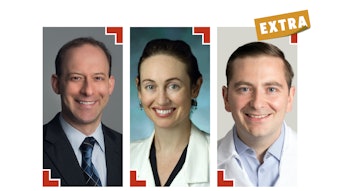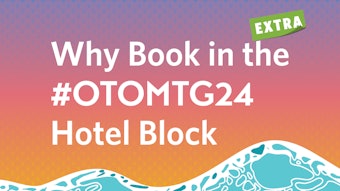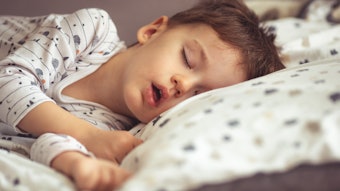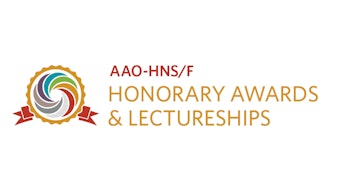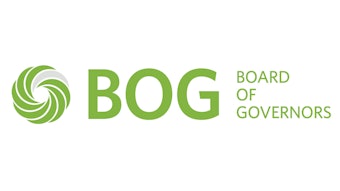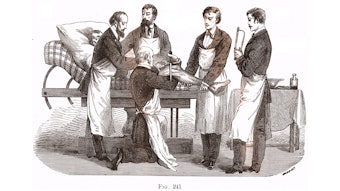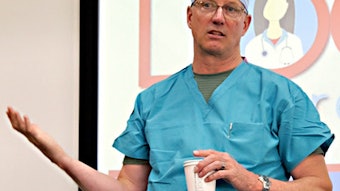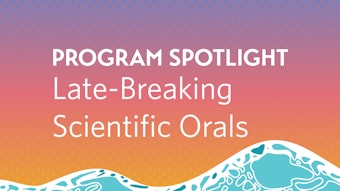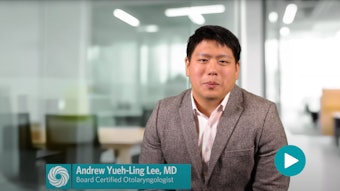Concentric Collapse Treatments for Obstructive Sleep Apnea
Current treatments for this challenging condition include lifestyle changes, medications or appliances, and soft-tissue or skeletal surgery.
Rahul Alapati, MD, and Christopher G. Larsen, MD, on behalf of the Sleep Disorders Committee
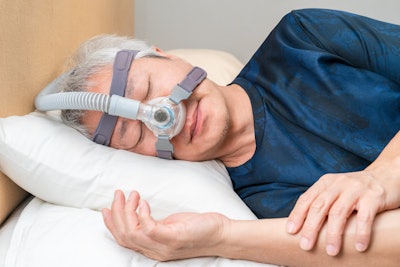
Airway collapse can occur at four different levels: velum, oropharynx, base of the tongue, and epiglottis. The area of obstruction or collapse can be identified through drug-induced sleep endoscopy. The gold standard treatment for all airway collapse patterns is continuous positive airway pressure; however, compliance is often poor owing to low tolerance.1 The majority of anterior-posterior (AP) collapse at the velum and base of the tongue is treated with the FDA-approved unilateral hypoglossal nerve stimulation (HGNS) system (Inspire®), while complete concentric collapse (CCC) of the airway is more challenging to treat with nerve stimulation. Current CCC treatment options include lifestyle changes, medications or appliances, soft-tissue surgery, or skeletal surgery.
Lifestyle, Therapy, and Oral Appliances
Weight loss is the first-line treatment modality, which can be achieved through lifestyle modifications, bariatric surgery, or new GLP-1 modulation medications. A 10% reduction in body weight can result in a 25% – 40% decrease in the apnea-hypopnea index (AHI) owing to a reduction in tongue fat, which increases the lateral distance of the retropalatal airway and decreases the volume of the lateral pharyngeal walls.3,4
Oropharyngeal physical therapy exercises have also been evaluated for treating OSA. In one study, patients performed various lip, tongue, jaw, palatal, buccinator, and pterygoid exercises, with sleep metrics evaluated pre- and post-therapy. Although there was no significant reduction in AHI, there were significant improvements in daytime sleepiness, snoring intensity, witnessed apnea, minimum oxygen saturation, time below 90% oxygen saturation, sleep efficiency, arousal index, and total sleep time.5 Notably, this study did not assess the specific airway collapse patterns of the patients, so the benefits for those with CCC remain uncertain.
Oral appliance therapy is a nonsurgical management option that can reduce AHI by up to 50% for patients with CCC.6 The oral appliance functions by pulling the mandible forward, creating tension along the soft tissues of the airway and preventing collapse during sleep. Additionally, a neuromuscular electrical stimulation device (eXciteOSA®) can also mitigate symptoms of OSA via daytime transmucosal electrical stimulation to the tongue musculature to improve tongue muscle tone during sleep. Studies evaluating this device highlight resolution of mild OSA and note objective reduction of snoring in 95% of participants.7, 8
Soft Tissue Surgery
Expansion sphincter pharyngoplasty (ESP) is one of various surgical modalities employed to manage complete CCC. A multicenter, randomized study evaluated a combination of ESP and radiofrequency ablation of the tongue base, which resulted in a significant decrease in both AHI and Epworth Sleepiness Scale scores compared with medical management alone.9 Other surgeons have tested a two-stage surgical approach combining ESP with subsequent HGNS implantation. Among the 20 patients enrolled, all exhibited conversion of their CCC to AP collapse; five had resolution of palatal collapse, 11 had partial AP collapse, and the remaining four had complete AP collapse. With the staged HGNS following ESP, patients experienced significant reductions in overall AHI, from 53.9 to 8.2.10 Furthermore, some providers attempted to convert CCC to AP collapse through a modified palatopharyngoplasty (PPP). Although only 12 patients were enrolled in the study, three had resolution of CCC at the velum, while the remaining nine showed conversion to AP collapse.11
Skeletal Surgery
Skeletal surgery, including hyoid suspension and maxillomandibular advancement (MMA), is another treatment modality for OSA. Hyoid suspension involves suturing the hyoid bone to the thyroid cartilage or suspending the hyoid to bone anchored screws in the mandible, thereby pulling the epiglottis, tongue base, and soft tissues of the airway forward, creating tension, and decreasing collapsibility. When combined with UPPP, hyoid advancement and suspension was found to significantly improve AHI and clinical symptoms.12 Alternatively, MMA involves advancing both the maxilla and mandible, thereby creating tension on all levels of the airway and reducing tissue collapsibility.13 Although MMA is effective in treating OSA, its invasive nature, longer recovery time, and higher risk of complications deter many patients from opting for this treatment.
Innovations in Progress
The unilateral hypoglossal nerve stimulator has revolutionized OSA therapy for patients with AP collapse. Similarly, Genio®, a bilateral hypoglossal nerve stimulator, aims to benefit patients with CCC (ACCCESS clinical trial NCT559002). Although multiple studies have demonstrated its utility and success, the device is still undergoing trials and awaits FDA approval in the United States.14-17
Overall, various management modalities are available for OSA. Lifestyle modifications, physical therapy, and non-surgical treatments are effective in treating OSA. Surgical options have shown significant improvements in patients with CCC. Although skeletal surgeries are effective, their invasive nature limits patient acceptance. Innovative therapies, such as the bilateral hypoglossal nerve stimulator, offer promising results but require further validation and FDA approval. Clinicians should remain cognizant of the multitude of treatment options for patients with CCC and strive to offer therapies that align with their patients’ care goals.
References
- Spicuzza L, Caruso D, Di Maria G. Obstructive sleep apnoea syndrome and its management. Ther Adv Chronic Dis. 2015;6(5):273-285
- Eckert DJ, Malhotra A. Pathophysiology of adult obstructive sleep apnea. Proc Am Thorac Soc. 2008;5(2):144-153. doi:10.1513/pats.200707-114MG
- Wang SH, Keenan BT, Wiemken A, et al. Effect of Weight Loss on Upper Airway Anatomy and the Apnea-Hypopnea Index. The Importance of Tongue Fat. Am J Respir Crit Care Med. 2020;201(6):718-727.
- Sutherland K, Smith G, Lowth AB, et al. The effect of surgical weight loss on upper airway fat in obstructive sleep apnoea. Sleep Breath. 2023;27(4):1333-1341.
- Verma RK, Johnson J JR, Goyal M, Banumathy N, Goswami U, Panda NK. Oropharyngeal exercises in the treatment of obstructive sleep apnoea: our experience. Sleep Breath. 2016;20(4):1193-1201. doi:10.1007/s11325-016-1332-1
- Ramar K, Dort LC, Katz SG, et al. Clinical Practice Guideline for the Treatment of Obstructive Sleep Apnea and Snoring with Oral Appliance Therapy: An Update for 2015. J Clin Sleep Med. 2015;11(7):773-827.
- Baptista PM, Martínez Ruiz de Apodaca P, Carrasco M, et al. Daytime Neuromuscular Electrical Therapy of Tongue Muscles in Improving Snoring in Individuals with Primary Snoring and Mild Obstructive Sleep Apnea. J Clin Med. 2021;10(9):1883. doi:10.3390/jcm10091883
- Kotecha B, Wong PY, Zhang H, Hassaan A. A novel intraoral neuromuscular stimulation device for treating sleep-disordered breathing. Sleep Breath. 2021;25(4):2083-2090. doi:10.1007/s11325-021-02355-7
- MacKay S, Carney AS, Catcheside PG, et al. Effect of Multilevel Upper Airway Surgery vs Medical Management on the Apnea-Hypopnea Index and Patient-Reported Daytime Sleepiness Among Patients With Moderate or Severe Obstructive Sleep Apnea: The SAMS Randomized Clinical Trial. JAMA. 2020;324(12):1168-1179.
- Weidenbecher MS, Vargo JW, Carter JC. Efficacy of expansion pharyngoplasty and hypoglossal nerve stimulation in treating sleep apnea. Am J Otolaryngol. 2022;43(5):103592.
- Liu SY, Hutz MJ, Poomkonsarn S, Chang CP, Awad M, Capasso R. Palatopharyngoplasty Resolves Concentric Collapse in Patients Ineligible for Upper Airway Stimulation. Laryngoscope. 2020;130(12):E958-E962.
- Van Tassel J, Chio E, Silverman D, Nord RS, Platter D, Abidin MR. Hyoid Suspension With UPPP for the Treatment of Obstructive Sleep Apnea. Ear Nose Throat J. 2023;102(5):NP212-NP219. doi:10.1177/01455613211001132
- Zaghi S, Holty JE, Certal V, et al. Maxillomandibular Advancement for Treatment of Obstructive Sleep Apnea: A Meta-analysis. JAMA Otolaryngol Head Neck Surg. 2016;142(1):58-66.
- Lewis R, Pételle B, Campbell MC, et al. Implantation of the nyxoah bilateral hypoglossal nerve stimulator for obstructive sleep apnea. Laryngoscope Investig Otolaryngol. 2019;4(6):703-707. doi:10.1002/lio2.312
- Eastwood PR, Barnes M, MacKay SG, et al. Bilateral hypoglossal nerve stimulation for treatment of adult obstructive sleep apnoea. Eur Respir J. 2020;55(1):1901320. Published 2020 Jan 9. doi:10.1183/13993003.01320-2019
- Heiser C, Sommer JU, Hofauer B, et al. Bilateral vs Unilateral Hypoglossal Nerve Stimulation in Patients With Obstructive Sleep Apnea. OTO Open. 2022;6(3):2473974X221109794. Published 2022 Jul 6. doi:10.1177/2473974X221109794
- Lewis R, Le J, Czank C, Raux G. Control of OSA in a patient with CCC of soft palate using bilateral hypoglossal nerve stimulation. Clin Case Rep. 2021;9(4):2222-2224. Published 2021 Feb 27. doi:10.1002/ccr3.3990



